Fun Science / A Brief History of Light (part 1)
Although gravity is the aspect of nature that most people seem to be familiar with, it is not the force that determines in the greatest extent our world. The electromagnetic force is the one that rules our lives: the chair you are sitting right now, the fact that you can see the computer screen, the punching of the keyboard keys, your body atoms held together, the brain thinking, and all types of communication, from the TV and eyesight to the internet work due to the electromagnetic force.
It is no coincidence that the peak of the industrial revolution that ultimately determined the fate of our civilization today happened soon after Maxwell at 1873 published his 4 equations that almost completely describe light.
The main issue of the theories of light was to resolve whether it is a wave or a particle, and this proved to be a not a simple task. It started as a particle from the ancient Greeks, then it became a wave with Huygens, then Newton suggested a particle theory again, then Fresnel and others suggested a wave theory again, then Einstein suggested a particle theory once more, until finally Quantum Mechanics settled it down: it is both a wave and a particle! Now everyone is happy except for the fact that none understands what that really means…
Huygens vs. Newton
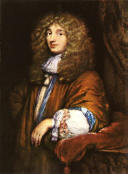
Christian Huygens was born at 1629, while Isaac Newton was born at 1643. Huygens was the first to build a mechanical clock, making use of Galileo’s realization that a swinging pendulum kept a regular rhythm. He build the first of this type of clocks at the age of 28, and a year later his design was used to all major churches in Holland. Later on when he was 45 he built the first watch ever, winning the race from Hooke, Newton’s great rival. At 1690, when he was 61, he fully published his wave theory of light, suggesting that it propagates as a disturbance (spherical pressure wave) in the air. One of the most important predictions of his theory was that light should propagate slower in a denser medium, something that was not experimentally confirmed until the next century.
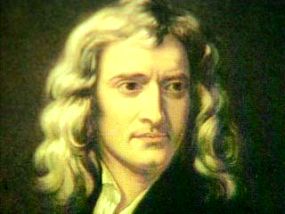
Newton was working on his particle theory of light at the same time as Huygens. Due to the enormous effect of his theory on gravity, he was already considered a grandmaster of science. Therefore his particle theory of light won the battle with Huygens’ theory of waves and his theory was most widely accepted in scientific community. He assumed that light consisted of particles, which he called corpuscles. In 1669 in a series of lectures he delivered in Cambridge, he explained his theory of colors and specifically the fact that a prism alters the color of the white light.
Until then it was thought that the white light is the purest form of energy, and that by traveling inside a prism it came out colored because it got “infected” from the glass. Newton performed a series of experiments and proved that it was actually the other way round: that white light was a mixture of all colors, and the prism actually distinguished between these colors.
He proved that by placing a second prism after the first one, and he realized that light of a certain color did not change color again as it traveled inside the second prism. Newton is considered the greatest scientist ever because he was the first to incorporate experiment and theory as a way of defining science: proposing something and then using experiments to confirm it or not. All of science after him works in the same exact way.
Newton had a great rival, Robert Hooke, who also published a theory of light, supporting the wavelike nature. He attacked him be claiming that his theory was wrong, and this led Newton to retract and disappear from the scientific matters for several years. Newton answered by saying his infamous remark “If I had seen further, it is by standing on the shoulders of giants”.
Although it is generally believed that Newton said this remark for his work on gravity, this is not justifiable by his esoteric and angry personality; he was not a man fond of big words. Rather, when he said that he was referring to Hooke, in the sense that he himself had build a theory of light based on previous work of great people (giants), but not on Hooke’s ideas who wanted to minimize Newton. Newton never published his theory of light until after Hooke actually died. This corpuscle theory of light dominated for several years.
The Wave Era Starts: Thomas Young
Thomas Young was born in 1773 (Newton had died in 1727) and provided the first strong evidence that light was a wave. It is interesting to note that at the age of 16 he spoke fluently 12 languages and he also worked on archaeology and Egyptology, also by trying to decipher the Rosetta Stone. He was the first to realize that the color vision that we have was the result of the combination of three different colors, and that the eye therefore contains three different kinds of detectors, one for each color. His greatest achievement though was the experiments he conducted with “the two holes”, and experiment that became of the greatest importance in the 20th century under the theory of Quantum Mechanics.

Even before his time people new that light seemed to behave strangely when we look at the edges of shadows, or in the boundaries between light and shadow. Newton’s theory was working pretty good in a crude level, but when one looked more closely fringes and color interference occurred. It was apparent that something was going on in these limiting cases and Young was the first to investigate it thoroughly.
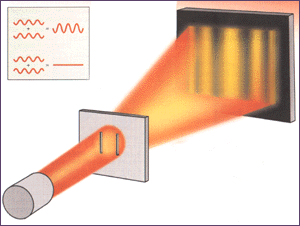
In this experiment, he shined light on a barrier that that contained two tiny holes, at the size of a millionth of a meter, and observed the peculiar pattern that resulted on a screen after the barrier. If light was consisting of corpuscles, one would expect to see 2 dots on the screen, one behind each hole. Yet what Young saw was a complex interference pattern, a pattern that could only be produced if light was acting as a wave and light from the two holes interfered. In fact the middle of the screen, the portion that is right behind the center of the barrier contains the most bright light, and not the portions behind the holes!
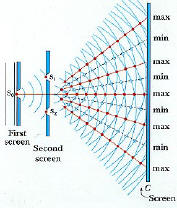
It took so long to realize this phenomenon because of the tiny wavelength of light: only when the holes are also tiny, at the size of this wavelength, only then can the wave effects be reproduced. However even after Young’s theory of wave light very few people actually believed him. That happened mainly for two reasons: First, Newton was a “god” and people couldn’t just disprove him like that. Second, it didn’t make sense to people how can you can darkness in the screen of the two-hole experiment by adding two light rays/waves!
Indeed, if you just ponder about it for a moment, you put a bright light ray together with another bright light ray, and instead of getting something twice as bright you get nothing! Zero! How could that be? This phenomenon might seem completely reasonable to us today but that was insane to think of at the 1700’s. Therefore Young’s theory had to wait for even more strong evidence in order for the wavelike behavior of light to be firmly established.
Wave Domination: Augustin Fresnel
In 1817 the French Academy of Sciences was determined to resolve once and for all the nature of light, so they announced a competition with a prize for the person who would provide the mist accurate explanation of light. The events that took place consist one of the most exciting stories of science.

One of the few participants was Augustin Fresnel, 29 years old at that time, who had already worked a very mathematical and detailed wave theory of light. In fact, the math where so hard that even himself couldn’t solve the required equations for the various diffraction problems he examined. Yet he decided to submit his 135-page work in the competition.
Now, the committee that decided the importance of the work was by no means average scientists: Simeon Poisson, Jean Biot and Pierre Laplace were all top-notch scientific figures at the time. Also, they all supported the Newtonian theory of corpuscle light so they didn’t regard Fresnel’s work with great zeal. Poisson himself worked hard to solve some of Fresnel’s equations, but he came across an absurd result. Everyone could more or less accept the fringes created in the edges of objects as a result of interference of waves.
But Poisson’s calculations showed that when an opaque stop is illuminated by light, then if Fresnel’s theory was correct there should be a bright spot directly behind the stop! The issue that had risen was major: maybe it was ok to have bright areas near the edges of an object, but now a bright spot should appear directly behind the object… The idea seemed to defy logic, and Poisson submitted these calculation as a proof that Fresnel’s theory was wrong.
Of course the decision wouldn’t be made solely on calculations. The chairman of the committee, Francois Arago, ordered the corresponding experiment to be carried out. In 1819 Arago wrote in the final report concluding the results of the experiment:
One of our commissioners, M. Poisson, had deduced from the integrals reported by the author [Fresnel] the singular result that the centre of the shadow of an opaque circular screen must, when the rays penetrate there at incidences which are only a little more oblique, be just illuminated as if the screen did not exist. The consequence has been submitted to the test of a direct experiment, and observation has perfectly confirmed the calculation.
And that was the end of Newton’s theory of light. The wave theory was now firmly established, and over the course of the next few years very detailed descriptions were to come about. (Fresnel didn’t see much of it since he died 9 years after his result was fully acknowledged.
The Bookbinder’s Apprentice: Michael Faraday
Faraday was born in 1791. He initially worked as a bookbinder, but he quickly realized that he was meant to do science. He attended lectures on physics and chemistry from which he kept detailed and accurate notes, which he then bound in books. When his apprenticeship was over, he pursued a job in the Royal Institution, which he only managed to get after a stroke of luck, when an assistant got into a fight and he was sacked for brawling. So he started working there after all at the age of 21. During his 56-year course there he turned down offers of knighthood and the presidency of the society.
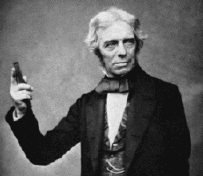
Faraday carried out an exhausting series of experiments in order to determine the nature of electricity and magnetism ( by that time it was not concluded that light is directly related to these guys). He was no good as a mathematician, but he had an excellent pictorial ability. His most important contribution is the notion of fields and field lines.
He proposed that electric and magnetic effects are the results of field lines produced by the sources. Instead of an actual mechanical substance that transmits the waves (like air) he claimed that what propagates is actually the field lines, and that light is the result of the vibration of these field lines. This spectacular insight still holds true until today, and not only about electromagnetic forces but for all forces as well (like gravity).
In his classic example, he questioned what would happen if the earth was magically placed in his appropriate distance from the sun? How would the earth know how to behave? He claimed that even before the earth is out there, the influence of the sun permeates space and exists there without the need of an object. He said that the earth doesn’t know anything about the sun itself, all she feels is the fields that the sun produces!
Along this concept of field lines Faraday (about 1846) managed to explain a long series of experiments with electric and magnetic forces, even how electricity can create magnetism when a charge is moving. He set the physical concept under which vibrations of these field lines would explain all phenomena in electromagnetism. Yet it was Maxwell who summed up mathematically these phenomena is the greatest achievement of science since Newton.
Light’s Grandmaster: James Clerk Maxwell
Maxwell, born in 1831, did for electromagnetism what Newton did for gravity. He summed up all previous efforts and descriptions on electric and magnetic phenomena, and found 4 equations (laws) that could describe everything related to them. He started out by being astonished from the fact that the equations of motion that seemed to describe electric phenomena appeared to be the same as the equations that described heat and water (fluids). He developed the analogy that the field lines of electric forces were in analogy with the streamlines of an incompressible fluid. His physical picture was slightly wrong, but the equations he worked out were far more important.
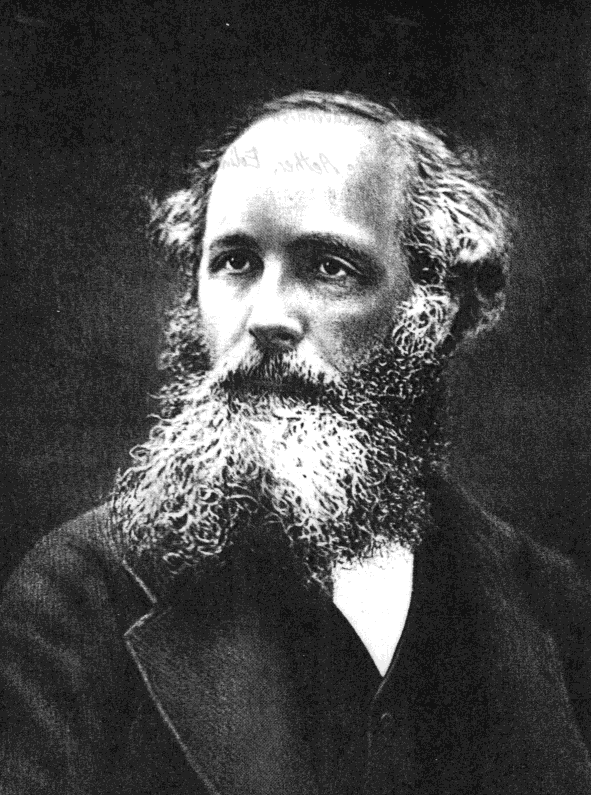
While working his equations though he noticed something interesting: a physical constant appears in there, a constant that was the speed with which electromagnetic waves propagate. The value of this constant was 300,000 Km/sec, and it forced Maxwell to ponder about the nature of light: light was known by then to move at a speed that was almost equal to this 300,000 Km/sec value. Maxwell thought that this could not have been a mere coincidence: it must be true that the light is in fact an electromagnetic wave!
The velocity is so nearly that of light that it seems we have strong reason to conclude that light itself is an electromagnetic disturbance in the form of waves propagated through the electromagnetic field according to electromagnetic laws.
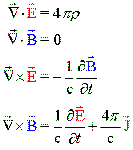
In 1864, at the age of 33, he published his famous paper that these 4 equations appeared for the first time complete. All everyday electromagnetic phenomena can be explained starting from these equation, from electric power to satellite tv and phones. Over the next 100 years physicists and engineers took the most out of these equations and built thousands of everyday applications.
Newton might be considered more important scientist than Maxwell because himself first applied the scientific way of thinking that we still use today, but if we want to talk about a single person that his ideas affected the most our everyday world then Maxwell stands out. In that sense his discoveries are more important that Einstein’s: Einstein provided a groundbreaking physical picture of the world, but its ramifications in everyday practical aspects is not yet as great as Maxwell’s discoveries.
It is interesting to know that Maxwell also worked on a broad range of physical phenomena, including the kinetic theory of gases (hence the maxwellian distribution), heat and thermodynamics, the nature of the rings of Saturn, an estimate of the size of molecules, and most importantly, he invented color photography!
Maxwell knew about Young’s ideas that human color vision is the result of the combination of three different kinds of receptors in the human eye. So he was the first to try and produce a color image by combining three differently colored filters. In a famous presentation he made in 1861, he presented this application is front of an audience (that also included Faraday).
He had three different black-and-white colorless images, and by projecting them through three filters (a red, a blue and a green one) at the same area of a screen the resulting picture was a fully colored image, for the first time ever. Almost all cameras and image recording devices today use this exact same principle. What Maxwell didn’t know at that time was that his example worked by luck… As it turned out later on, the plate that contained the information that was to be projected through the red filter did not record red light at all!
So what kind of light was projected through the red filter? The mystery was solved 100 years later in the Kodak laboratories: the plate recorded and reflected ultraviolet light instead of red, but it also happened that the filter also was transparent to ultraviolet light too, so it it went through it and was “colored” red by the filter. This double coincidence led ultimately to the success of the experiment, despite Maxwell’s ignorance.
When a space probe sends back today color images of the rings of Saturn, we essentially record the rings that first Maxwell explained with color pictures using Maxwell’s technique and send them back to earth using electromagnetic waves that also Maxwell explained.
Epilogue
In 1864 with Maxwell’s equations ends a huge battle on understanding and manipulating light. In terms of practical applications, everything was settled as light was a wave and people now knew how to use the equations to control it. In the next 100 years however new discoveries came about regarding not so much how we can manipulate light, but regarding what light really is. The real nature of light was uncovered inside the theory of relativity and quantum mechanics.
